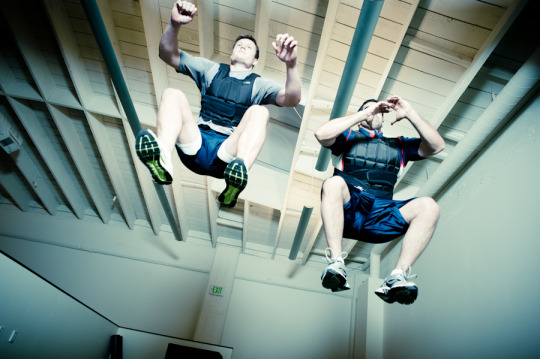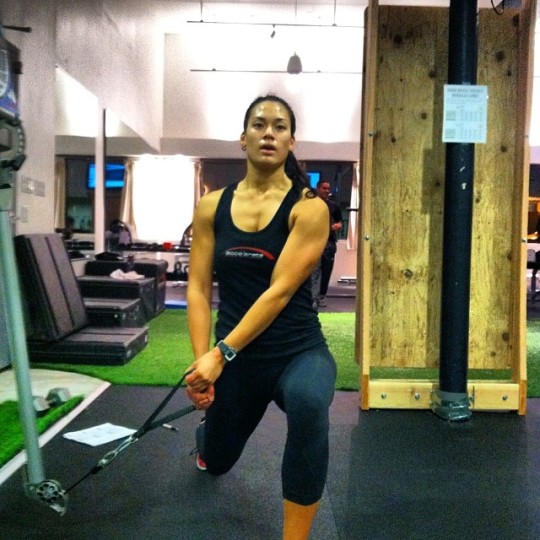Video
Bungee #resisted #sprint #sanfrancisco #bayarea (at Accelerate Sports Performance)
0 notes
Photo

#asp #sf #sports #performace #strength #flexibility #mobility #girl #lift (at Accelerate Sports Performance)
0 notes
Photo


THE BASICS OF THE STRETCH-SHORTENING CYCLE AND INCREASING POWER PRODUCTION IN ATHLETES
The stretch-shortening cycle is incredibly important to all athletes, occurring when a muscle or muscle group is rapidly stretched. In powerful movements and plyometric exercise, muscles go through three different phases of the stretch-shortening cycle: (1) eccentric, (2) ammortization, and (3) concentric.
The faster an athlete can switch from an eccentric load to an concentric contraction in their training, the more powerful and explosive the athlete ultimately will be during their competition.
Let’s dive deeper into understanding the science behind this important cycle.
ECCENTRIC PHASE
In a jump squat with counter movement, the eccentric phase occurs as the athlete lowers their hips back into a squatting position. During that lowering motion, the body is stretching and preloading the agonist muscle groups, (glutes, hamstrings, calves) storing elastic energy to be used on a subsequent concentric muscle action, and stimulating muscle spindles.
The stronger we become in the eccentric loading phase, the more proficient those muscle spindles become at muscle fiber recruitment for the explosive concentric phase.
This is also why we focus so much on the loading technique at ASP. If an athlete is using poor technique in the loading phase of the Jump Squat, then the wrong muscle groups are being stretched or the primary movers are not working as efficiently which will lead to a sub-optimal concentric contraction and jump, dissipated stored muscle energy, and the increased possibility of injury. One of the many ways that we train this eccentric phase is by implementing various lower body eccentric stability and relaxation exercises during the lower body elasticity portion of the workout.
By improving the loading technique and capability, we look to improve power from the following concentric action. During the stretch that occurs during the eccentric phase, muscle spindles fibers send feedback to the central nervous system telling the muscles to contract as a protective response to prevent tissue damage from further stretching. This means due to the reflexive response of the agonist muscles, the greater the stretch rate=the greater the muscle recruitment (Kramer et.al., 2012)(Baechle et.al., 2000).
AMMORTIZATION PHASE
This is the transition phase between the eccentric muscle action and the concentric muscle action. The ammortization phase is when motor neurons transmit to the agonist muscles telling them to contract. This may be the most crucial phase in power production. The quicker an athlete can switch from an eccentric contraction to a concentric contraction, the more power they will be able to produce.
If it takes too long for the muscle or muscle groups to transfer the eccentric force to a concentric force, the energy stored will dissipate and be lost.
CONCENTRIC PHASE
The final phase of the stretch-shortening cycle is the concentric phase, where the agonist muscles use the stretch reflex and stored elastic energy to contract and produce power. This is often the simplest phase and the easiest to train. Staying with the squat jump with counter movement example from earlier, this is where the agonist muscles that were stretched during the eccentric loading phase fire to apply force into the ground and ascend into a jump.
CONCLUSION
We always take a very controlled approach to training the stretch-shortening cycle through in every ASP athlete because:
(a) it is significant in power production
(b) it’s also very easy to load into an incorrect and/or dangerous loading pattern if the force or load is too great or improperly variable.
At the beginning of every workout we include the lower body elasticity section, starting with very basic loading positions, in order to not only gain eccentric strength but to remind our athletes physically and neurologically the correct position to be in. This will aid in kinesthetic awareness, strength, and increased comfort when they progress to more dynamic movements in their training and in their athletic competition.
1.) Kraemer, W., Looney, D. Underlying Mechanisms and physiology of Muscle Power. Strength and Conditioning Journal. 2012, 34, 6, 13-19.
1.) Baechle, T., Earle, R. 2000. Essentials of Strength Training and Conditioning. 2nd edition. National Strength and Conditioning Association. 428-430 p.
2 notes
·
View notes
Photo

#asp #sanfrancisco #strength #athlete (at Accelerate Sports Performance)
1 note
·
View note
Video
youtube
With rising numbers of lower leg injuries, and the growing number of amateur runners both recreationally, and semi-competitively in marathons and triathlons, we decided to enlighten those interested with an introduction to a few simple structures, deficiencies, and rehab tools use with both our professional and amateur athlete populations.
Flat Feet – Symptoms, Structures, and Management
Flat feet are a lowering or collapse of the medial longitudinal arch. Left untreated, this structural condition can lead to pronation at the ankle joint. Excessive pronation can cause pain and stress to several structures, including musculature and ligaments (Prentice, 2004). Today’s blog will outline the visual symptoms, associated structures, and a management plan for flat feet.

Figure 1 displays a posterior view of the left foot and ankle. On the right side, a collapse of the medial arch is shown indicating flat feet. On the left side, there is a sign of “too many toes” which is associated with mid-foot abduction. Also displayed in Figure 1, but not labeled, is an eversion of the calcaneus and a medial bulge of the talar head. With repeated pronation during weight-bearing activities (standing, walking, running), increased stress will be placed along the medial aspect of the ankle. As a result, Figure 2 shows swelling and edema posterior to the medial malleolus of the right foot. These are all visual symptoms of flat feet or ankle pronation.

A common tendon injury associated with flat feet is the tibialis posterior tendon (Yuill, 2010). The tibialis posterior originates at the adjacent margins of the tibia and fibula and runs posterior to the medial malleolus, then inserts at the navicular, medial cuneiform, and the 2nd-4th metatarsals (middle/inside of the foot). With flat feet and ankle pronation, strain is placed on the tendon (as shown in Figure 3) and stress occurs on the deltoid ligament of the medial ankle as displayed in Figure 4. Both the tibialis posterior and the deltoid ligaments serve to protect the ankle from excess eversion.
There are a variety of ways to manage pain and prevent injuries. On the path back to performance training or incorporated into performance training:
(1) The first step is to support the flattened arch through the use of orthotics.
(2) Next, we want incorporate a stretching program to ensure full range of motion in all planes.
(3) After an adequate level of range of motion has been established, a strength program can be added.
(4) Finally, proprioception and balance exercises will be trained to enhance neuromuscular control.
A primary aspect that we try to focus on is having the athlete train with a stable medial longitudinal arch. Although three distinct arches function to support the foot, the medial longitudinal arch has been found to be the arch of clinical significance in preventing injury due to flat feet (Franco, 1987).

ORTHOTICS
One way to manage flat feet is by using orthotics. The main function of an orthotic is to provide a combination of neuromuscular reeducation and a change in body mechanics in an attempt to readjust the foot into a more ideal weight baring position (Franco, 1987). A proper fitting orthotic provides mechanical support to the flattened medial longitudinal arch and prevents further tendon lengthening or ligament stress. The muscles that are constantly being stressed and lengthened are then, finally relaxed and shortened.
EXERCISES
While the orthotic passively creates an arch for the athlete and may help prevent overuse injuries, it is also important for the athlete to actively train and strengthen muscles that are underactive during over pronation. A program that incorporates the strengthening of the anterior and posterior tibialis is important because they help maintain a proper arch. Without the use of an orthotic, the athlete can work towards biomechanical betterment by practicing “bilateral short foot position.”
https://www.youtube.com/watch?v=oxU9uC5FHF4#t=7
Other exercises that should be incorporated into the athlete’s program to build strength in the ankle and lower leg include isometric exercises against all planes of motion. After that, the athlete can progress to concentric and eccentric movements using tubing or resistance bands and onward.
Kinesthetic awareness can be regained through multiple balance training exercises. One balance exercise that we may incorporate into the rehab training is a single leg RDL. While a main objective of this exercise is to strengthen the posterior chain, performing an RDL on one leg also forces the athlete to focus on balance, thus improving neuromuscular control at the ankle, lower leg, hip, and torso. Another way we improve balance is by having the athlete stand on a soft, unstable pad while throwing a ball for them to catch. When the athlete reacts to catch the ball, they must stabilize the foot and lower leg.
While these are general exercises for ankle and lower leg rehabilitation, athletes respond to treatment and exercises differently, so modifications should be made accordingly.
In the next blog post, we will talk about the effects of over pronation up the kinetic chain.
References
Howitt S, Jung S, Hammonds N. Conservative treatment of a tibialis posterior strain in a novice triathlete: a case report. Journal of the Canadian Chiropractic Association Mar2009, Vol. 53 Issue 1, p23 9p.
Yuill E, MacIntyre I. Posterior tibialis tendonopathy in an adolescent soccer player: a case report. Journal of the Canadian Chiropractic Association Dec2010, Vol. 54 Issue 4, p293 8p.
Kulig K, Reischl SF, Pomrantz AB, Burnfield JM, Mais-Requejo S, Thordarson DB, Smith RW. Nonsurgical Management of Posterior Tibial Tendon Dysfunction With Orthoses and Resistive Exercise: A Randomized Controlled Trial. Physical Therapy Jan2009, Vol. 89 Issue 1, p26 12p.
Mattacola, Carl & Dwyer, Maureen. Rehabilitation of the ankle after acute sprain or chronic instability. Journal of Athletic Training. 2002 Oct.; 37 (4); 413-429.
Prentice W. Rehabilitation Techniques for Sports Medicine and Athletic Training Fourth Edition 2004.
1 note
·
View note
Video
An Emotional Return Back to Play
ASP athlete and Sacred Heart Cathedral Varsity Basketball player Kayla Coloyan recently returned from an ACL injury to help win an emotional 47 - 39 victory over St. Ignatius.
With four steals and leading an early 10-3 run in the third with a three-point play, "Kayla gave us a big boost," basketball coach LyRyan Russell said. "She always gives us instant energy."
Please read more about Kayla and her team’s success in the SF Chronicle.
Congrats Kayla! We couldn’t be more proud of you returning back to play stronger than ever.
0 notes
Photo

#deadlift #strength (at Accelerate Sports Performance)
0 notes
Photo

Today's menu #lunch #ASP #therightratios (at Accelerate Sports Performance)
0 notes
Photo

#nutrition set for the week (at Accelerate Sports Performance)
0 notes
Photo

And he's off to Spring Training. Have a great season #ChaseUtley #baseball #springtraining #sports (at Accelerate Sports Performance)
0 notes
Video
youtube
Anterior cruciate ligament injuries are very common injuries and one of the most debilitating injuries that an athlete can suffer. These injuries are even more common in female athletes. Studies have shown that females are between 2 and 3 times more likely to suffer an ACL tear, with female basketball players up to 6 times more likely to suffer a non-contact ACL injury than males with similar exposure hours to the sport (Ireland).
http://youtu.be/lSqBhDgT4b0
This particular athlete is returning from an ACL repair in her right knee. She is performing a Keiser resisted vertical jump with minimal load. We want her to execute this vertical jump without a countermovement to familiarize her with the correct biomechanics/firing pattern of the jump. We’re also eccentrically loading her back into the correct position again on the landing before we have her add a stretch-reflex component with a countermovement.
In the beginning phase of this athlete’s program, she exhibits many of the patterns that increase the risk of an ACL injury. On the ascent of the jump, her right femur internally rotates at the hip and the tibia is externally rotated as she pronates at the ankle. This valgus position of the knee and pronation of the ankle puts the ACL in a vulnerable position. This is due to the hip extensors, abductors, and or external rotators not firing properly or staying dormant, therefore the femur falls into an internally rotated position. After time, this becomes a learned neuromuscular movement pattern.
Subconsciously, the pictured athlete utilizes a stretch-reflex with a countermovement change of direction before her jump (although not instructed to do so) without sound biomechanics. In this particular case, the issue is not due to a lack of strength, but a firing pattern issue of the hip extensors, external rotators and abductors. Our goal is to continue improving her jumping/landing biomechanics as reduce risk of reinjury through better kinesthetic awareness.
Here is an image of the biomechanical etiology of an ACL tear as we described in this instance, (as there are other mechanisms) in a more gross form followed by an image of the actual injury on the field of play by NFL athlete and QB of the washington Redskins, Robert Griffin III.


http://youtu.be/lSqBhDgT4b0
In week three of our athlete’s program, we can see significant improvement with a particular focus on queuing the loading pattern. In this video progression, the athlete executes the exercise with much more sound eccentric form, attacking the ground with her feet, readying herself to move in the other direction. In the first video from her first week of this phase, notice that her landing position is completely vertical and she is only “catching” herself into the landing, finding support in a structural fashion rather than an elastic fashion. She has gained the neuromuscular adaptations necessary to execute better, yet still not perfect, jumping and landing biomechanics.
We want to put the athlete in a more advantageous position utilizing her larger/stronger muscles, and stabilize with her smaller muscles; to not only strengthen, but prevent future ACL re-injury. By utilizing the vertical jump (in addition to other elements within her program) and tracking her progress over time, we will continue to work on her proprioceptive awareness, loading patterns, and dynamic strength and power development.
1.) Ireland, Mary Loyd MD, Anterior Cruciate Ligament Injury in Female Athletes: Epidemiology. Journal of Athletic Training. 1999, 34, 2, 150-154.
0 notes
Video
youtube
In this series, we have Bri performing the B March. This exercise is used to help develop proper sprint mechanics; specifically appropriate hip flexion and knee extension, plus the act of hip extension by pulling our foot through the ground strike phase. We coach the athlete to act as if they are trying to get gum off of their shoe to reinforce the concept of pulling through our sprint strides, as opposed to pushing off. This exercise is also geared to training the correct location for the foot strike, which is when the midfoot of the stride leg is even with the toes of the stabilizing foot. As with all other sprint techniques the strides are performed with all leg and arm movements in the sagittal plane without any lateral or medial deviations.
http://youtu.be/ov14HWmpNOU
As we can see in her first attempt at the B March, there are considerable inefficiencies in the movement. Starting with the knee flexed during the initial stride phase, which prevents a full hamstring stretch. Ideally, we would see terminal extension at the knee, giving us a straight line from hip to heel. We also have passive foot striking. There is little to no hip extension to facilitate a dynamic pull of the foot as it makes contact with the ground. Lastly, the arm action becomes stagnant during the recovery phase. We would like to see both arms keep 90 degrees of flexion at the elbows during both the stride and recovery swings. Over weeks of practice this drill and general sprint mechanics will improve as seen below:
http://youtu.be/RDaq1hnlNrw
In this second video we can see Bri has increased in a couple of specific areas. First, the leg swing is initiated with better knee extension. With better knee extension comes a more dynamic hamstring stretch, and a more activated hamstring executes a more powerful stretch reflex to pull the leg through the ground strike and recovery phases. This is why we also see an improvement in the pull portion of this movement. The foot is now more dynamic when it makes contact with the ground and you can see the hip extension pulling her into each stride. Still the recovery hand tends to fall to the ground as opposed to seeing the elbow pull through the recovery swing while keeping both elbows flexed. In the next video we will see improvements in overall technique and tempo:
http://youtu.be/0Jceg4hFYt4
In this final video we see all of the desired components coming together after nearly one month of twice per week training of this specific movement pattern. With the continuous training Bri was able to synchronize her arm and leg movements and achieve a more dynamic tempo. Full leg extension paired with her feet attacking the ground when the strike the floor allow her to move more efficiently in her lower half. Proper arm swinging helps her to stabilize her upper body as well as assist her with pulling herself through each stride, which is the preferred sprint technique.
THE FULL PROGRESSION: http://youtu.be/-a0KBd3yc6o
0 notes
Video
#sprint #form #biomechanics #running #speed #accelerate #cardio #anaerobic #sport #performance (at Accelerate Sports Performance)
0 notes
Photo

@mayalita_la_pajarita #cable #lift #sweat #run #surf sweat
0 notes


